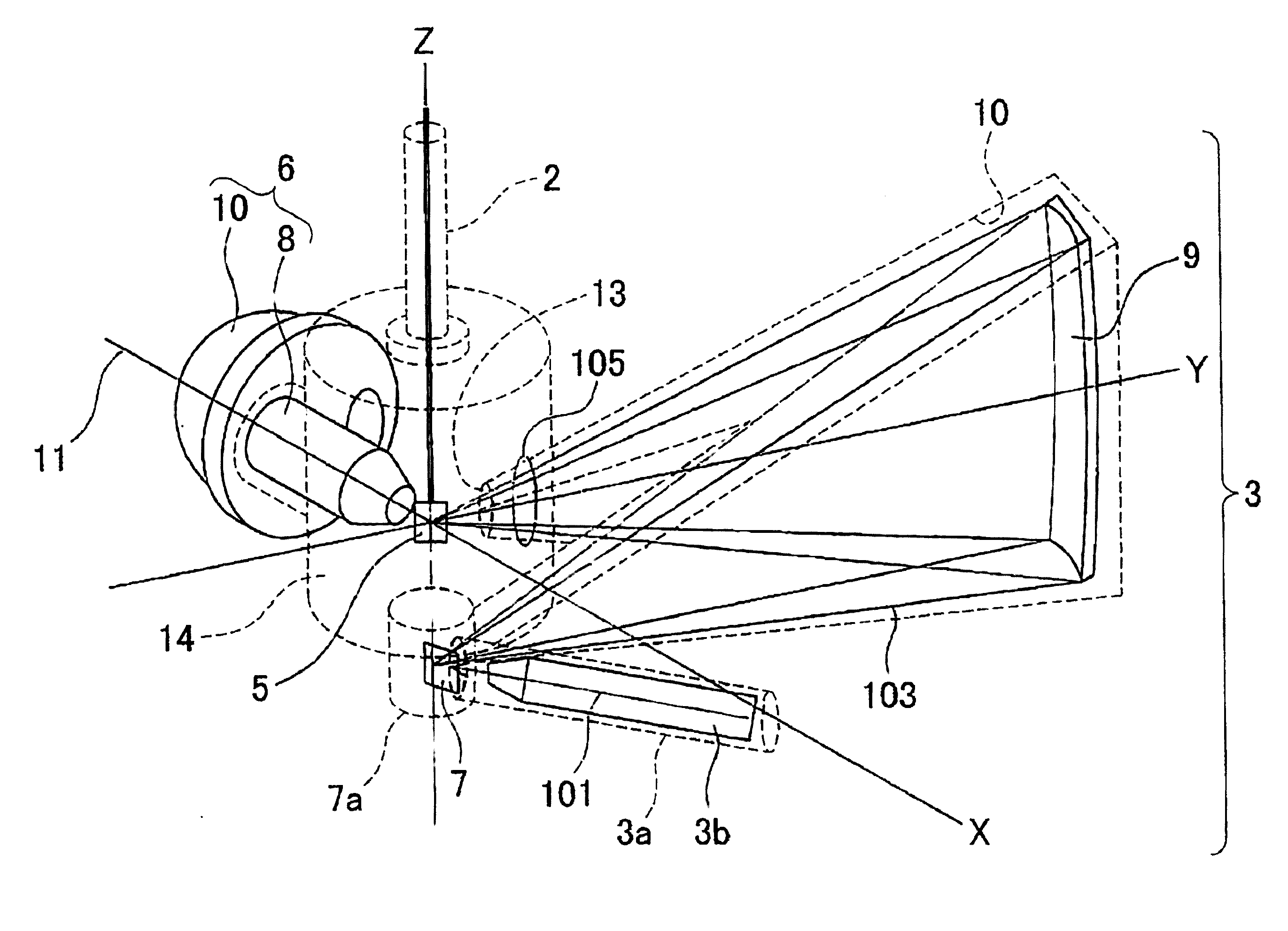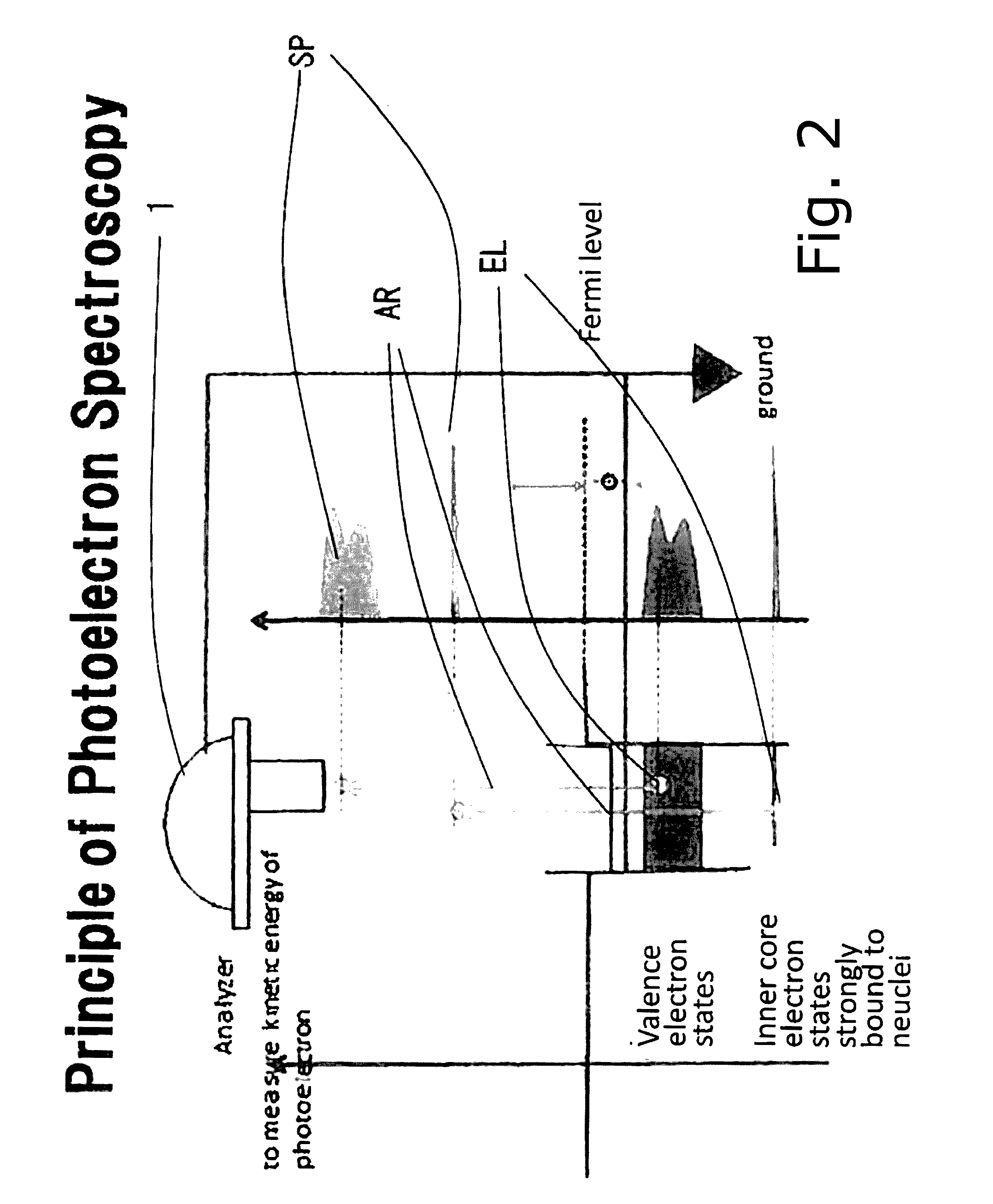Hard X-Ray Photoelectron Spectroscopy Apparatus
a technology of photoelectron spectroscopy and hard x-ray, which is applied in the field of hard x-ray photoelectron spectroscopy apparatus, can solve the problems of reducing the efficiency of conventional photoelectron spectroscopy, so as to increase the efficiency of photoelectron collection and maximize the efficiency of photoelectron
- Summary
- Abstract
- Description
- Claims
- Application Information
AI Technical Summary
Benefits of technology
Problems solved by technology
Method used
Image
Examples
embodiment 1
[0057]FIG. 6 is an illustration showing a configuration of the photoelectron spectroscopy apparatus according to the embodiment 1 of the present invention, and FIG. 7 is an illustration explaining a principle of a monochromatized X-ray source and a geometrical relationship between the X-ray source and a sample according to the present invention. Referring to FIG. 6 and FIG. 7, an electron beam (101) is accelerated and irradiated to a target (7) to generate an X-ray. For example, in the case of a target of Cr (hereinafter simply referred to as “Cr target”), the irradiation is typically conducted by focusing an electron beam accelerated to 20-30 keVit to about 100 microns. Then, X-ray beam (X-ray beam prior to monochromatization including a Bremsstrahlung X-ray etc.) (103) is emitted from the Cr target wherein a CrKα-ray having a peak at energy of 5.4 keV is overlapped with the Bremsstrahlung X-rays (a continuous spectrum emitted in the process where an electron slows down when it col...
embodiment 2
[0072]Another embodiment will be explained below which satisfies the conditions for the above-mentioned spatial configurations.
[0073]The inventors adopts in this embodiment the knowledge relating to another invention “X-Ray Generator and Analyzer” (U.S. Pat. No. 5,550,082; Inventors: KOBAYASHI, Keisuke, YAMAZUI, Hiromichi, IWAI, Hideo, and KOBATA, Masaaki), in which a configuration of the double-ray source switching and utilizing an AlKα-ray and CrKα-ray is suggested.
[0074]FIG. 9 shows an apparatus of this embodiment. This embodiment has a structure in which the analysis chamber and the X-ray source are integrated and the vacuum of the analysis chamber part and that of the X-ray source are divided by a partition to lead the X-ray through an X-ray window provided at the partition to the analysis chamber.
[0075]The target (7) is irradiated with an electron beam by the electron gun (3b) to generate an X-ray. There is an area coated with Al and Cr on the substrate of the target (7). The ...
embodiment 3
[0078]Yet another embodiment will be explained below which satisfies the conditions for the above-mentioned spatial configuration. In the embodiment 1, in order to achieve large X-ray flux, a structure is adopted which achieves a large acceptance angle of the monochromater crystal assembly, but there is a spatial restriction for this structure. It is considered that the output of the electron gun (3b) exciting the target for further increase of the X-ray flux is increased. However, if the output of the electron beam is increased exceeding the cooling capacity of the target (7), the target layer (7) will be damaged, since the most of energy of the electron beam turn into heat within the target layer (7). If the size of the spot (footprint (FP)) on the target (7) of the electron beam is increased, the density of the generated heat decreases, thereby preventing the damage to the target (7). However, the spot size on the target (7) of the electron beam corresponds to the size of the X-r...
PUM
| Property | Measurement | Unit |
|---|---|---|
| angle | aaaaa | aaaaa |
| energy | aaaaa | aaaaa |
| size | aaaaa | aaaaa |
Abstract
Description
Claims
Application Information
 Login to View More
Login to View More - R&D
- Intellectual Property
- Life Sciences
- Materials
- Tech Scout
- Unparalleled Data Quality
- Higher Quality Content
- 60% Fewer Hallucinations
Browse by: Latest US Patents, China's latest patents, Technical Efficacy Thesaurus, Application Domain, Technology Topic, Popular Technical Reports.
© 2025 PatSnap. All rights reserved.Legal|Privacy policy|Modern Slavery Act Transparency Statement|Sitemap|About US| Contact US: help@patsnap.com



